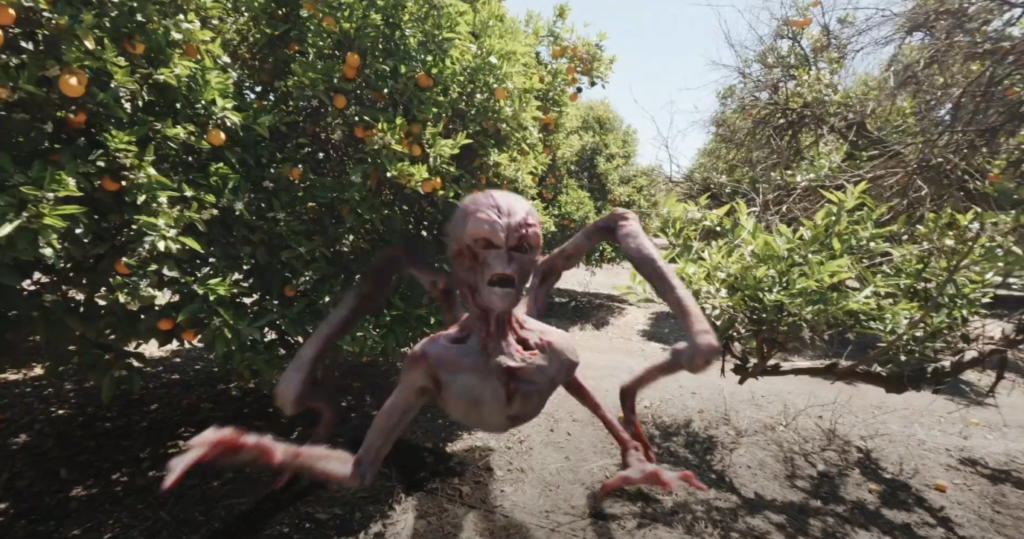I’ve always loved the V/H/S film franchise and anthology horror in general, because of the unpredictability and variety they offer. Each segment is like a new puzzle, with different directors bringing their unique visions and scares to the table. The found-footage format of V/H/S tape heightens that raw, immersive experience, making the horror feel more immediate and visceral.
There’s something thrilling about not knowing where the next story will take you — whether it’s supernatural, psychological or outright terrifying.
V/H/S: Viral is about the only one that didn’t hit the mark for me. The third film just felt disjointed, lacking the cohesion and creativity that made the earlier installments so engaging. Instead of the clever twists and scares I expect from the franchise, it seemed to fall flat, missing the intensity and originality that makes anthology horror so exciting.
Shudder clearly recognizes the appeal of the franchise, as the network has been consistently releasing new installments over the past several years — and to great fanfare. The streaming platform has leaned into the series’ cult following, tapping into the hunger for fresh, inventive horror content. With the anthology format allowing for multiple styles and subgenres of horror, it offers something for everyone — from hardcore horror fans to casual viewers.
Shudder’s dedication to the franchise underscores its belief in the continued success of V/H/S as a cornerstone of modern horror, feeding the audience’s appetite for terrifying, bite-sized stories with a unique found-footage twist.
V/H/S/Beyond is the latest installment in the franchise, released on October 4th, 2024. The anthology kicks off with “Stork,” where a police team raids a suspected child abduction ring, only to uncover a grisly creature at the heart of the operation. In “Dream Girl,” the second segment, a Bollywood rising star, Tara (Namrata Sheth), brings utter chaos to the set of her latest film after her manager forces her to take a break. Next up is “Live and Let Dive,” where a group of skydivers find themselves caught in the middle of an alien invasion.
“Fur Babies” follows a group of animal cruelty advocates who learn the terrifying consequences of confronting a completely unhinged dog lover. In “Stowaway,” a woman awakens aboard an alien ship, only to find her body mutating with every injury she sustains. Finally, the wraparound story, “Abduction/Adduction,” ties everything together as a skeptic enlists the help of YouTubers Corridor Crew to debunk a set of recovered VHS tapes that appear to provide undeniable evidence of alien contact.
The decision to focus heavily on sci-fi horror in V/H/S/Beyond, while bold, ultimately feels like a misstep. In previous installments, V/H/S thrived as a collection of eclectic stories, where one entry could feature vampires and the next might center on vengeful spirits. That variety kept things fresh and unpredictable. However, V/H/S/Beyond shifts almost entirely into the realm of science fiction, losing the balance that made the franchise so beloved by horror fans. It feels like the directing team decided a new direction was needed, despite the success of the previous formula.
In this case, the old saying, “If it ain’t broke, don’t fix it” applies. Unfortunately, we’re left with a series of loosely connected shorts that neither scare nor intrigue, lacking the diversity and intensity that fans have come to expect.
The biggest misstep in V/H/S/Beyond is that it seems to forget what made the franchise so popular in the first place: the found-footage aesthetic. In earlier installments, the audience feels a sense of voyeurism, like we’re watching something we shouldn’t be seeing. The gritty, grainy visuals, paired with the occasional glitches and tape anomalies created an immersive, unsettling atmosphere that amplified the horror. This raw, lo-fi presentation was a signature of the series, heightening the tension and making the stories feel more real and dangerous.
While V/H/S/Beyond attempts to recreate these moments, they come off as digital effects, rather than genuine VHS imperfections. The result is a much cleaner, polished presentation that lacks the raw edge that defined the earlier films. By stripping away the rough, distorted visuals, V/H/S/Beyond loses that immersive, voyeuristic quality, making it feel disconnected from the gritty, unsettling experience that fans of the franchise expect.
That’s not to say V/H/S/Beyond doesn’t have its fun moments. “Fur Babies” is the one story that steers clear of extraterrestrial themes, making it stand out from the rest in a refreshing way. Libby Letlow delivers a standout performance as the eccentric Becky, and throughout the segment, I couldn’t help but draw comparisons to Kathy Bates’ iconic role in 1990’s Misery. Becky initially comes across as overly sweet and devoted to the dogs she cares for, but there’s an unsettling vibe lurking beneath her cheerful exterior. When her true intentions are finally revealed, it feels completely in line with the character’s hidden motivations.
Instead of being an outlier for the wrong reasons, Fur Babies distinguishes itself in the best possible way.
I give V/H/S/Beyond two out of five stars. Personally, I’m not a huge fan of sci-fi horror, and this installment devotes much of its runtime to that genre, which didn’t resonate with me. That said, the visual effects are solid — nothing feels overly cheesy, and the CGI is decent, avoiding the pitfalls of bad digital work. However, my biggest disappointment is how the film abandons the franchise’s found-footage roots.
The grainy, chaotic charm that defined earlier films is largely absent here, which strips away a lot of the raw tension the series is known for. Instead of offering a compelling, varied narrative, V/H/S/Beyond feels flat, relying too heavily on alien monsters and rampaging robots without delivering much in the way of fresh horror.
Ultimately, it ranks near the bottom of the franchise, competing with V/H/S: Viral for the title of weakest entry.

